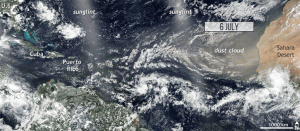
An atmospheric river carrying dust particles blows across the North Atlantic Ocean from Africa to the Caribbean in July 2018. (Credit: Suomi/NPP satellite images from NASA Worldview website. Animation by climate.gov) The full-size GIF animation can be seen on the Earth Imaging Journal homepage at www.eijournal.com.
Windy regions high in the atmosphere can transport pollutants such as dust or soot thousands of miles around the world and disrupt everyday life for thousands of people.
Last summer, Godzilla came for the Caribbean and the U.S. Gulf Coast. This particular monster wasn't of the sci-fi variety, but, rather, a massive dust storm kicked up by winds from the Sahara Desert and carried an ocean away.
The dust storm was an extreme example of a phenomenon that happens regularly: the global transport of dust, soot and other airborne particles, collectively known as aerosols, by jets of winds in the atmosphere. The result is the formation of what are called aerosol atmospheric rivers.
Gaining a better understanding of how these particles are transported around the globe is important because certain aerosols can nourish rainforest soil, help or hinder cloud formation, reduce visibility or affect air quality”which can impact human health. But studies of aerosol transport have tended to focus on single events in a particular part of the world. There wasn't a way of looking at them in a holistic, global way.
In a first, a recent study published in the journal Geophysical Research Letters does just that. Five types of aerosols are of particular interest to researchers: dust, two kinds of carbon particles (soot and organic carbon), sulfate (emitted during events like volcanic eruptions or the burning of fossil fuels) and sea salt. The authors identified where aerosol atmospheric rivers tend to occur and how often extreme events, similar to the Godzilla dust storm, happen each year. To do this, they took a computer program they previously developed to detect atmospheric rivers around the world that move water vapor and produce precipitation, and they modified it to detect aerosol atmospheric rivers instead.
The shift from using atmospheric rivers to study the movement of water vapor to using them to study aerosol transport was something of a revelation, because researchers only started to use the global detection framework of atmospheric rivers to look at the movement of extreme amounts of water vapor about six years ago. The concept of atmospheric rivers is only about 20 years old.

